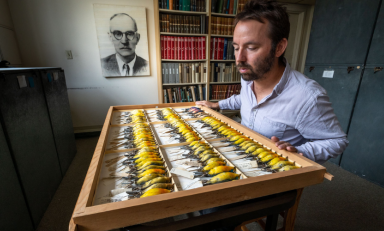A clear plan, political will, and a willingness to experiment are among the keys to reclaiming city streets for pedestrians, bicyclists, and more effective rapid transit, New York City Transportation Commissioner Janette Sadik-Khan '82 told a standing-room-only crowd in Occidental College's Keck Theater Thursday evening.
"You have to experiment, try things out," Sadik-Khan said in delivering the College's annual Antoinette and Vincent M. Dungan Lecture on Energy and the Environment. "If it doesn't work, OK, you move on and try something else."
Because of the perception that current transportation systems aren't working anyway, "There's no risk, except of falling behind and not being imaginative."
Asked what Los Angeles should be doing, Sadik-Khan told her audience of students, faculty, community leaders, local government planners and bicycle advocates that pilot programs are a good way to start - quick, inexpensive efforts that produce an immediate result.
"After my first year in my job, out of 8.4 million New Yorkers, it turns out there are 8.4 million traffic engineers. Who knew? Everyone has an opinion and so you can always find people who can oppose these new ideas -- everybody hates change -- but when you do it as an experiment, it's very hard to argue with. You get a lot of momentum that way."
Before the lecture began, Sadik-Khan was presented with an honorary degree by President Jonathan Veitch, Trustee Cathy Pepe '64, and Roger Boesche, Arthur G. Coons Professor in the History of Ideas, who Sadik-Khan said had a major impact on her life and career.
"Janette apparently told her mother that she wanted to do something that touched people's lives every day," Boesche said in an affectionate tribute to his former student. "Her mother told her that gave her two choices: transportation or sanitation. So Janette chose transportation."
Appointed by Mayor Michael Bloomberg in April 2007, Sadik-Khan has implemented an ambitious program to improve safety, mobility, street maintenance and sustainable practices throughout New York City. Under her leadership, in 2008 the Department of Transportation unveiled a new strategic plan, "Sustainable Streets," which for the first time laid out a clear, detailed transportation plan for the city - one that promised a new direction.
"You really need a policy framework," she said Thursday. "The public needs to know why you are doing what you are doing. What's the plan? You need to have a vision of where you are going to go."
Improving safety, she added, is a critically important part of any transportation plan. "Safety and sustainability go together. People won't bike or walk if they don't feel safe."
Over the past two years, the department has carried out a host of new initiatives, including completing the build-out of 200 miles of new bicycle lanes, implementing new roadway designs to improve safety, creating new public plazas, and bringing car-free summer streets and weekend pedestrian walks on some of the city's 6,000 miles of streets and highways. Last year, traffic accident deaths in New York City fell to an all-time low as bicycle commuting rose 35 percent.
"I want to treat streets as the valuable spaces they are," Sadik-Khan said. "We have 6,000 miles of streets in the city, and I consider myself to be the biggest real estate developer in New York, with all due respect to Donald Trump and others."
Much of her success as an innovator, she said, is due to the backing she has received from Mayor Bloomberg. "You have to have the political will to get things done," she said. "We have an incredible mayor in New York, probably one of the best we have ever had. He has said we have to take a long-term view of the city."
But it's not always possible to predict outcomes, even with careful planning and preparation, she cautioned. Last year, Sadik-Khan launched what is probably her best-known initiative - creating pedestrian islands on Broadway by barring traffic from 47th to 42nd streets and 35th to 33rd streets. One of the chief goals was to improve traffic flows in Manhattan, but it was the beach chairs placed in the newly created pedestrian plazas in Times and Herald squares that got all the attention.
"That's the only thing the public talked about," she said. "We just closed Broadway, and all they talked about was the beach chairs. So if you ever have a controversial project, just put up some beach chairs."



